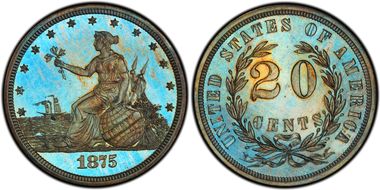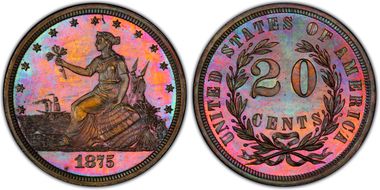- PCGS #:
- 61711
- Designer:
- N/A
- Edge:
- N/A
- Diameter:
- N/A
- Weight:
- N/A
- Mintage:
- N/A
- Mint:
- Philadelphia
- Metal:
- Copper
- Auction Record:
- $24,000 • PR65BN • 05-08-2022 • Heritage Auctions
Condition Census What Is This?
Patterns for a Twenty Cents coin were first proposed in 1874, in response to a request from Western states, whose populace held non-silver coins in disdain yet complained that they did not have enough coins to make small change! The new denomination was authorized by the Act of March 3, 1875 and production began on May 19, 1875.
All the pattern designs of 1875 were created by William Barber, who adopted a nautical theme for the year. His "Sailor Head" design (Judd 1392-1395) lost out to the Seated Liberty design, which matched stylistically the coins already being produced by the Mint.
For Judd-1404, Pollock recorded six weights (ranging from 55.2-61.9 grains), two diameters (of .86 inches), and he noted that all the examples seen by him had a die alignment of 180 degrees.
Judd called the obverse "Liberty at the Seashore."
The reverse of this Pattern was also used on 1874 Pattern Twenty Cents (Judd 1357 and 1358).
Sources and/or recommended reading: "United States Pattern, Experimental And Trial Pieces" by J. Hewitt Judd, M.D.
"United States Patterns And Related Issues" by Andrew W. Pollock III




